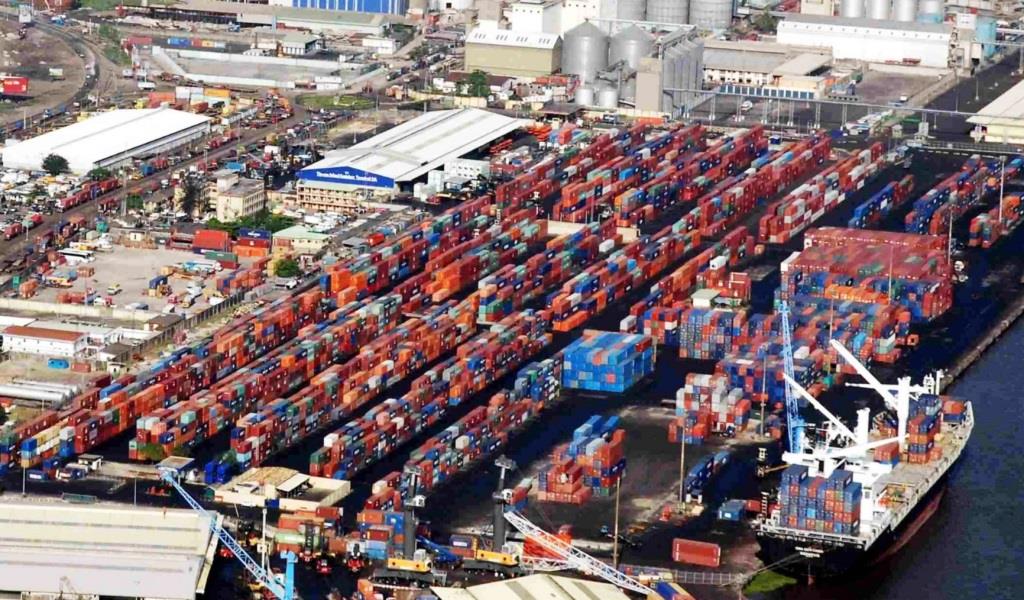General
NPA Targets Functional Digital Ports by 2025

By Adedapo Adesanya
The Nigerian Ports Authority (NPA) has begun deliberate measures and investments for a fully digital ecosystem across the country by 2025.
This was disclosed by the Acting Managing Director, Mr Mohammed Bello-Koko, at the 41st Ports Management Association of West and Central Africa (PMAWCA) Annual Council Meeting and 16th Round-table Conference of Managing Directors of PMAWCA in Douala, Cameroon.
He stressed that as the international supply chain battles several disruptions, the agency would focus on port smartness level than its size, in order to optimise productivity and meet users’ expectations.
In his presentation on Digitalisation Roadmap and Current Information and Communications Technology (ICT) Implementation Status, Mr Bello-Koko stated that “at NPA, our goal is to leverage on technology to close the gap between us and the major international ports.”
He noted that “a digitalised port helps in making better informed operational decisions, increase efficiency, improve collaboration among stakeholders, lower port costs and ultimately help to meet the ever-increasing customer expectations in a timely manner.”
The NPA MD, who was represented at the forum by the Executive Director, Engineering and Technical Services, Mr Idris Abubakar, disclosed that the NPA was currently implementing a five-year plan for a fully digitalised port system in Nigeria, and has so far deployed a portfolio of systems and infrastructure towards the actualisation of its ICT objectives.
These include Oracle Enterprise Business Suite for financial and human resources planning, Billing/Revenue and Invoice Management System (RIMS) to fast-track billing processing, Customer Portal/electronic Ship Entry Notice (eSEN)/Manifest Upload for shipping traffic management and Hyperion Budgeting for management of the annual budget.
Others are the Command, Control, Communication and Intelligence System (3Ci) for maritime domain awareness and management of vessel calls, Truck Call-up and Gate Access Control for the control and scheduling of trucks to the ports as well as to manage truck traffic around the port corridor.
He explained that should the target be actualised on the set date, it would be exactly 50 years after Nigeria first deployed the main computer system (in 1975) to improve its payroll management, billing, statistical and accounting systems.
He noted that since 1975 when NPA first deployed the main computer system to improve its payroll management, billing, statistical and accounting systems, a lot of work has gone into its smart port transformation agenda aimed at bringing about paperless, time-saving and cost-efficient port operations.
He explained that from 1992, the deployment of personal computers was done at each port location to ease data management, while information sharing remained difficult due to the absence of connectivity between the ports, he added.
Then in 2011, the agency reviewed its ICT strategy in line with its new role as landlord, following the concession of port terminals in 2006, with a focus on enterprise computing and heavy dependence on network infrastructure, along with a centralised and shared database.
Its adoption of a phased ICT deployment is geared towards achieving a fully integrated port operating system to foster relationships with all internal and external stakeholders, streamline NPA’s internal business processes, use high-end smart technologies, as well as record, monitor and utilise data for better decision making.
On his part, the President of PMAWCA and Director-General of Ghana Ports and Harbours Authority (GPHA), Mr Michael Luguje, said the digitised model was very relevant because more than ever, COVID-19 has brought its importance.
“Within a space of time, the dynamics with regards to world trade and our ways of life can change dramatically.
“The impact of COVID-19 cannot be swept under the carpet so easily. Countries are now rebuilding after many years of economic progress has been wiped off.
“As leaders in the maritime field entrusted with the responsibilities of facilitating trade and economic progress for our respective countries, we are here for serious discussion on how we can continue to adjust in the face of this unwavering virus, and how to plan and operate our ports to meet future challenges.
“The main aim is to explore diverse ways of using less to achieve more through the use of smart technologies.”
General
Christmas: Tinubu Calls for Religious Tolerance Amid Rising Insecurity

By Adedapo Adesanya
President Bola Tinubu has called on Nigerians to embrace religious tolerance, peace, and unity, urging citizens of all faiths to reject violence and intolerance amid ongoing security challenges across the country.
In his 2025 Christmas goodwill message issued on Wednesday by his Special Adviser on Information and Strategy, Mr Mr Bayo Onanuga, the President emphasised that no Nigerian should suffer discrimination or violence because of their religious beliefs, reaffirming his administration’s commitment to safeguarding freedom of worship and national cohesion.
“As your President, I remain committed to doing everything within my power to enshrine religious freedom in Nigeria and to protect all people of different faiths from violence,” Mr Tinubu said, noting that all Nigerians have the constitutional right to live, worship, and pursue their aspirations in safety and dignity.
The President acknowledged growing concerns around religious intolerance and insecurity, revealing that he had engaged extensively throughout the year with leaders of Nigeria’s two major faiths.
In the last few months, the country faced a spate of attacks including kidnapping of school children and armed terror, involving the death of a high ranking army personnel.
He also said the government would continue to build on these engagements to strengthen collaboration with religious institutions, prevent conflict, and promote peaceful coexistence.
President Tinubu described Christmas as a period for reflection on the message of Jesus Christ as the Prince of Peace, urging Nigerians to draw inspiration from values of love, compassion, and goodwill that cut across all major religions.
He commended Christians in Nigeria for their contributions to national development, particularly their role in caring for the vulnerable and promoting harmony within communities.
“The love for God and love for humanity is at the heart of all the great faiths. These shared values must continue to bind us together as one indivisible and resilient people,” he said.
Reiterating his administration’s stance on security, the President said the government’s commitment to protecting Nigeria’s unity and stability has remained unwavering since he assumed office in 2023. He stressed that the state would not tolerate violence targeted at any group on the basis of ethnicity or belief.
President Tinubu also appealed to Nigerians travelling during the festive season to exercise patience and discipline on the roads, wishing them safe journeys and returns.
Expressing optimism about the country’s future, the President said that with faith in God and collective resolve, Nigeria would overcome its challenges and build a nation that future generations would be proud of.
He concluded by wishing Christians in Nigeria and around the world a Merry Christmas and Nigerians a happy New Year in advance.
General
FG Slams 16 Money Laundering Charges of N1.014bn Against Malami

By Adedapo Adesanya
The federal government has filed 16 alleged money laundering charges, to the tune of N1.014 billion, against a former Attorney-General of the Federation and Minister of Justice, Mr Abubakar Malami (SAN), and his son, Mr Abubakar Abdulaziz Malami, before the Federal High Court in Abuja.
Also listed as a co-defendant in the case is Hajia Bashir Asabe.
According to the charge, the government is accusing Mr Malami, his son, and others of being involved in the laundering and concealment of N1,014,848,500.00 allegedly traced to a commercial bank.
In the 16 charges, the Nigerian government alleged that between July 2022 and June 2025, within Abuja and the jurisdiction of the court, the defendants procured Metropolitan Auto Tech Limited to conceal the unlawful origin of the money.
The charge alleges, in part, that the defendants used the company as a front to conceal the origin and movement of the funds, an act the government says constitutes money laundering under Nigerian law.
The alleged offence is said to be contrary to Section 21(c) of the Money Laundering (Prevention and Prohibition) Act, 2022, and punishable under Section 18(3) of the same Act.
The 16 charges reveal how Malami allegedly engaged Metropolitan Auto Tech Limited to launder funds.
The charges are as follows:
“That you Abubakar Malami SAN, and Abubakar Abdulaziz Malami between July 2022 and June, 2025 in Abuja within the jurisdiction of this Honourable Court did procure Metropolitan Auto Tech Limited to conceal the unlawful origin of the total sum of N1, 014, 848, 500.00 (One Billion, Fourteen Million, Eight Hundred and Forty Eight Thousand, Five Hundred Naira) in the Sterling Bank Plc Account No. 0079182387 when you reasonably ought to have known that the said sum formed proceeds of unlawful activities and you thereby committed an offence contrary to Section 21(c) of the Money Laundering (Prevention and Prohibition) Act 2022 and punishable under Section 18(3) of the same Act.
“That you Abubakar Malami SAN whilst being the Attorney-General of the Federation, and Abubakar Abdulaziz Malami between September 2020 and February, 2021in Abuja within the jurisdiction of this Honourable Court did procure Metropolitan Auto Tech Limited to conceal the unlawful origin of the total sum of N600,013,460.4 in the Sterling Bank Plc Account No. 0079182387 when you reasonably ought to have known that the said sum formed proceeds of unlawful activities and you thereby committed an offence contrary to Section 18(c) of the Money Laundering Prohibition Act 2011 as amended by Act No. 1 of 2012) and punishable under section 15(3) of the same Act
“That you Abubakar Malami SAN whilst being the Attorney-General of the Federation and Abubakar Abdulaziz Malami sometime in March, 2021 in Abuja within the jurisdiction of this Honourable Court did retain the total sum of N600,000,000.00 in Metropolitan Auto Tech Limited as cash collateral for a loan of N500,000,000.00 granted to RAYHAAN HOTELS LTD by Sterling Bank Plc when you reasonably ought to have known that the said cash collateral of N600,000,000.00 was proceed of unlawful activities and you thereby committed an offence contrary to Section 18(c) of the Money Laundering Prohibition Act 2011 as amendedpunishable under section 15(3) of the same Act
“That you Abubakar Malami SAN whilst being the Attorney-General of the Federation, Abubakar Abdulaziz Malami, and Hajia Bashir Asabe an employee of Rahamaniyya Properties Limited sometime in November, 2022 in Abuja within the jurisdiction of this Honourable Court did indirectly disguise the unlawful origin of the aggregate sum of N500,000,000.00 paid to Efab Properties Ltd paid for purchase of property known as luxury duplex at Amazon street, Plot No. 3011 within Cadastral Zone A06 Maitama District, Abuja in favour of Abubakar Malami SAN when you reasonably ought to have known that the said N500million formed proceed of unlawful activity and you thereby committed an offence contrary to section 18(2) (a) and punishable under section 18(3) of the Money Laundering (Prevention and Prohibition) Act, 2022.
“That you Abubakar Malami SAN, Abubakar Abdulaziz Malami, and Hajia Bashir Asabe an employee of Rahamaniyya Properties Ltd sometimes in September 2024 in Abuja within the jurisdiction of this Honourable Court conspired to disguise the unlawful origin of the aggregate sum of N1,049,173,926.13 paid through the Union Bank Plc account of Meethaq Hotels Ltd Jabi savings Account No. 0179011105 between November 2022 and September 2024 and you thereby committed an offence contrary to Section 21 of the Money Laundering (Prevention and Prohibition Act) 2022 and punishable under Section 18(2) (a) and (3) of the same Act.
“That you Abubakar Malami SAN, and Abubakar Abdulaziz Malami between November 2022 and October, 2025 indirectly took control of the aggregate sum of N1,362,887,872.96 paid through the savings account of Meethaq Hotels Limited in Union Bank Plc when you reasonably ought to have known that the said funds formed proceeds of unlawful activity and you thereby committed an offence contrary to Section 18(2) (d) and punishable under Section 18(3) of the Money Laundering (Prevention and Prohibition) Act, 2022.
“That you Abubakar Malami SAN whilst being the Attorney-General of the Federation and Hajia Bashir Asabe an employee of Rahamaniyya Properties Ltd sometimes between November and December, 2018 in Abuja within the jurisdiction of this Honourable Court indirectly concealed the unlawful origin of the aggregate sum of N700,000,000.00 paid for the purchase of the property described as No. 3 Onitsha Crescent Area 11, Garki Abuja (Hamonia Hotels Ltd) in favour of Abubakar Malami SAN when you reasonably ought to have known that the said sum of N700, 000,000.00formed proceeds of unlawful activityand you thereby committed an offence contrary to section 15(2) (d) and punishable under section 15(3) of the Money Laundering (Prohibition) Act, 2011 as amended.
“That you Abubakar Malami SAN whilst being the Attorney-General of the Federation, Abubakar Abdulaziz Malami and Hajia Bashir Asabe an employee of Rahamaniyya Properties Ltdsometimes between September 2020 and December, 2020 in Abuja within the jurisdiction of this Honourable Court, indirectly concealed the aggregate sum of N850,000,000.00 paid for the purchase of property described as Plot 683 Jabi District Cadastral Zone B04 (Meethaq Hotels Ltd, Jabi) when you reasonably ought to have known that the said sum of N850, 000, 000.00 represented proceeds of unlawful activity and you thereby committed an offence contrary to Section 15(2) (d) and punishable under Section 15(3) of the Money Laundering (Prohibition) Act, 2011 as amended.
“That you Abubakar Malami SAN whilst being the Attorney-General of the Federation and Hajia Bashir Asabe an employee of Rahamaniyya Properties Limited on or about February, 2018 in Abuja within the jurisdiction of this Honourable Court indirectly acquired the property described as No. 3 Rhine Street Maitama, Abuja (Meethaq Hotels Ltd) for an aggregate sum of N430,000,000.00 when you reasonably ought to have known that the said sum of N430,000,000.00 formed proceeds of unlawful activity and you thereby committed an offence contrary to Section 15(2) (d) and punishable under Section 15(3) of the Money Laundering (Prohibition) Act, 2011 as amended.”
“That you Abubakar Malami SAN whilst being the Attorney-General of the Federation and Hajia Bashir Asabe an employee of Rahamaniyya Properties Ltd sometimes on or about February, 2018 in Abuja within the jurisdiction of this Honourable Court indirectly concealed the unlawful origin of the aggregate sum of N210,000,000.00 paid for the purchaseof the property described as No. 3130 Cadastral Zone A04 Asokoro District, Abuja in favour of Abubakar Malami SAN when you reasonably ought to have known that the said sum of N210, 000, 000,000.00 represented proceeds of unlawful activity and you thereby committed an offence contrary to section 15(2) (d) and punishable under Section 15(3) of the Money Laundering ( Prohibition) Act, 2011 as amended.
“That you Abubakar Malami SAN whilst being the Attorney-General of the Federation and Hajia Bashir Asabe an employee of Rahamaniyya Properties Ltd between March and June 2021 in Abuja within the jurisdiction of this Honourable Court indirectly concealed the unlawful origin of the aggregate sum of N325,000,000,000.00 paid for the purchase of property described as No. 1241B Asokoro District Zone (No. 11A Yakubu Gowon Crescent Asokoro) in favour of Abubakar Malami SAN when you reasonably ought to have known that the said sum of N325, 000, 000.00 represented proceed of unlawful activity and you thereby committed an offence contrary to section 15(2) (d) and punishable under section 15(3) of the Money Laundering ( Prohibition) Act, 2011 as amended.
“That you Abubakar Malami SAN whilst being the Attorney-General of the Federation and Hajia Bashir Asabe an employee of Rahamaniyya Properties Ltd between November 2015 and January, 2016 in Abuja within the jurisdiction of this Honourable Court indirectly concealed the unlawful origin of the aggregate sum of N120,000,000,000.00 paid for the purchase of property described as No. 27 Efab Estate 5th Avenue, 59th Crescent, Gwarimpa, Abuja in favour of Abubakar Malami SAN when you reasonably ought to have known that the said sum of N120, 000, 000.00 represented proceeds of unlawful activity and you thereby committed an offence contrary to section 15(2) (d) and punishable under section 15(3) of the Money Laundering ( Prohibition) Act, 2011 as amended.
“That you Abubakar Malami SANwhilst being the Attorney-General of the Federation, Abubakar Abdulaziz Malami, and Hajia Bashir Asabe an employee of Rahamaniyya Properties Ltd sometime in November, 2022 in Abuja within the jurisdiction of this Honourable Court did conspire amongst yourselves to conceal the unlawful origin of the funds paid for the purchase of property known as luxury duplex at Amazon street, Plot No. 3011 within Cadastral Zone A06 Maitama District, Abuja and you thereby committed an offence contrary to Section 21 of the Money Laundering (Prevention and Prohibition Act) 2022 and punishable under Section 18(2) (a) and (3) of the same Act.
“That you Abubakar Malami SAN whilst being the Attorney-General of the Federation, Hajia Bashir Asabe whilst being an employee of Rahamaniyya Properties Ltd and other persons at large between December, 2016 and April, 2022 in Abuja within the jurisdiction of this Honourable Court conspired amongst yourselves to indirectly acquire landed properties for Abubakar Malami SAN with proceeds of unlawful activity and you thereby committed an offence contrary to section 18 of the Money Laundering (Prohibition Act) 2011 and punishable under Section 15(2) (a) and (3) of the same Act.
“That you Abubakar Malami SAN whilst being the Attorney-General of the Federation, between June and January, 2023in Abuja within the jurisdiction of this Honourable Court indirectly concealed the unlawful origin of the aggregate sum N537,000,000.00 which you paid for the purchase of the properties namely (i) No. 26 Babbi Street, BUA Estate, Abuja, (ii) 4 bedroom Bungalow, Guesse 2 Brinin- Kebbi and (iii) No. 4 Ahmadu Bello Way, Kano, Nassarawa GRA, Kano knowing that the said sum of N537, 000,000.00formed proceeds of unlawful activity and you thereby committed an offence contrary to section 18(2) (a) and punishable under section 18(3) of the Money Laundering (Prevention and Prohibition) Act, 2022.
“That you Abubakar Malami SAN whilst being the Attorney-General of the Federation, between October 2018 and December, 2021 in Abuja within the jurisdiction of this Honourable Court indirectly concealed the aggregate sum N415,000,000.00 which you paid for the purchase of the properties namely (i) No. 28 Bagudu Kaltio crescent Gwarimpa, Abuja (ii) Plot 13, Ipent 7 Estate Abuja and (iii) A Plaza, Commercial Toilets, Laundry and Warehouse Tanks Adjacent to Brinin Kebbi Market (iv) 100 hectares of land Along Brinin Kebbi, Jeba Road (v) Plot 157 Lamido Crescent, Nassarawa Road GRA, Kano knowing that the said sum of N415,000,000.00 formed proceeds of unlawful activity and you thereby committed an offence contrary to Section 15(2) (a) and punishable under Section 15(3) of the Money Laundering Prohibition Act, 2011 as amended.”
Mr Malami served as Attorney-General and Minister of Justice from 2015 to 2023 under the administration of former President Muhammadu Buhari.
General
KWAM 1 Ends Awujale Ambition, Withdraws Legal Challenge

By Adedapo Adesanya
Fuji musician, Mr Wasiu Ayinde, popularly known as K1 De Ultimate or KWAM 1, has formally withdrawn from the race for the Awujale of Ijebuland after staunch opposition to his ambitions.
This came as the minstrel filed a notice of discontinuation at the Ogun State High Court to end his legal challenge against the ongoing selection process.
The notice, filed on Monday, December 22, 2025, by his legal team led by Mr Wahab Shittu (SAN), brings to a close his controversial bid for the revered throne.
The withdrawal followed a ruling by Justice A. A. Omoniyi of High Court 3, Ijebu-Ode Judicial Division, who dismissed KWAM 1’s application for an interim injunction seeking to restrain the Ogun State Governor, Mr Dapo Abiodun, the Fusengbuwa Ruling House and other parties from proceeding with the selection of a new Awujale.
Justice Omoniyi held that the application lacked merit but ruled that the substantive suit could proceed on its merits, fixing January 14, 2026, for further hearing.
KWAM 1, the Olori Omooba of Ijebuland from the Fidipote Ruling House, had approached the court after the Fusengbuwa Ruling House declared him ineligible to contest for the stool, insisting he was not a bona fide member of the ruling house and therefore could not vie for the throne under its platform.
However, with the filing of the notice of discontinuation, KWAM 1 appears to have formally recused himself from the Awujale selection process, effectively ending his challenge.
He joined as respondents in the case: the Ogun State Governor, the Commissioner for Local Government and Chieftaincy Affairs, the Attorney General and Commissioner for Justice, the Secretary of Ijebu-Ode Local Government, the Chairman of the Awujale Interregnum Administrative Council, and the Chairman of the Fusengbuwa Ruling House.
In the application, KWAM 1 contended that he is a bonafide member of both the Fusengbuwa and Fidipote ruling houses, and that his rights as a potential candidate were being threatened by what he described as a flawed and unlawful process.
He alleged that the Awujale Interregnum Administrative Council, which he described as an “unrecognised body”, was exerting influence over the nomination procedure in violation of Ogun State chieftaincy laws.
Central to his claim was the argument that due process was not followed, particularly the requirement that the Ijebu-Ode Local Government formally publish the names of the 13 recognised kingmakers before any selection exercise commences.
KWAM 1 maintained that the failure to comply with this step rendered the process vulnerable to legal challenge.
The suit was filed against the backdrop of the vacancy created by the death of Oba Sikiru Kayode Adetona in July, at the age of 91, after a reign of more than six decades.
-

 Feature/OPED6 years ago
Feature/OPED6 years agoDavos was Different this year
-
Travel/Tourism9 years ago
Lagos Seals Western Lodge Hotel In Ikorodu
-

 Showbiz3 years ago
Showbiz3 years agoEstranged Lover Releases Videos of Empress Njamah Bathing
-

 Banking8 years ago
Banking8 years agoSort Codes of GTBank Branches in Nigeria
-

 Economy3 years ago
Economy3 years agoSubsidy Removal: CNG at N130 Per Litre Cheaper Than Petrol—IPMAN
-

 Banking3 years ago
Banking3 years agoFirst Bank Announces Planned Downtime
-

 Banking3 years ago
Banking3 years agoSort Codes of UBA Branches in Nigeria
-

 Sports3 years ago
Sports3 years agoHighest Paid Nigerian Footballer – How Much Do Nigerian Footballers Earn













